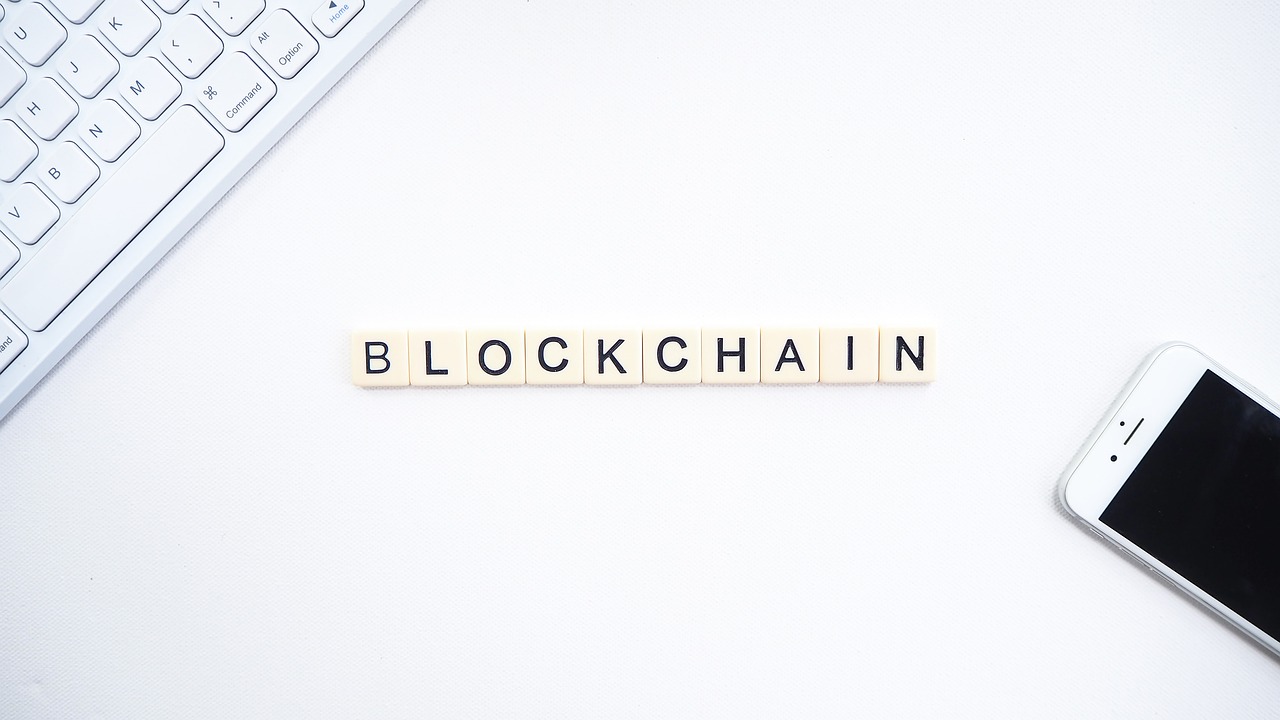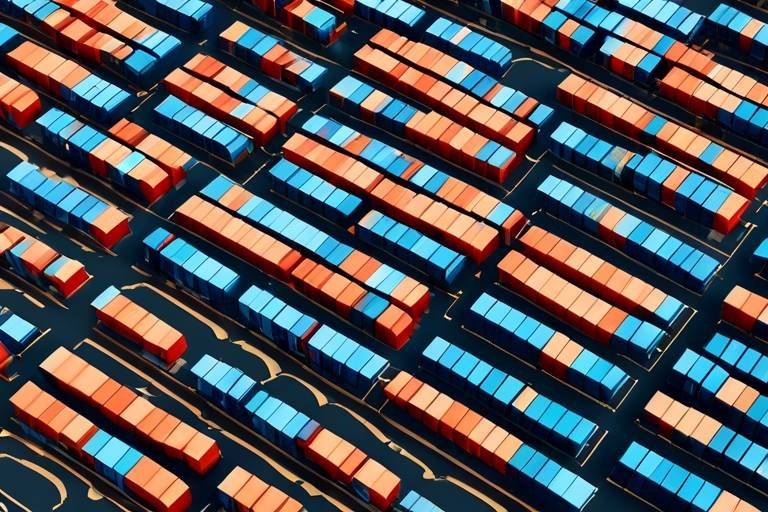The Role of Blockchain in International Trade
In today's fast-paced global economy, the way we conduct international trade is undergoing a seismic shift, thanks to blockchain technology. Imagine a world where every transaction is not only secure but also transparent, where fraud is minimized, and processes are streamlined to the point of near-effortlessness. This is not just a dream; it's the reality that blockchain is paving the way for in the realm of global commerce. By enhancing transparency, reducing fraud, and simplifying complex processes, blockchain is set to revolutionize how businesses operate across borders.
So, what exactly is blockchain? At its core, it is a decentralized ledger technology that allows for secure and transparent transactions without the need for a central authority. Unlike traditional databases that can be manipulated or compromised, blockchain provides an immutable record of transactions that all parties can trust. This fundamental difference is what makes it particularly appealing for international trade, where trust and reliability are paramount.
As we delve deeper into this fascinating topic, we'll explore the myriad benefits blockchain brings to international trade, from enhanced transparency and fraud prevention to streamlined processes that can save time and money. However, it's not all sunshine and rainbows; there are challenges to implementing this technology, including regulatory hurdles and integration issues that need to be addressed. We will also look at real-world case studies that highlight successful implementations of blockchain in trade, showcasing how businesses are leveraging this technology to gain a competitive edge.
In summary, the role of blockchain in international trade is not just a trend; it's a transformative force that has the potential to redefine the very fabric of global commerce. Are you ready to explore this exciting frontier with us? Let's dive in!
- What is blockchain technology? Blockchain is a decentralized ledger technology that allows for secure and transparent transactions.
- How does blockchain enhance transparency in trade? Blockchain provides all parties involved in a transaction access to the same information in real-time, fostering trust and accountability.
- What are some challenges of implementing blockchain in international trade? Key challenges include regulatory hurdles and integration issues with existing systems.
- Can blockchain prevent fraud in international trade? Yes, by providing a secure and immutable record of transactions, blockchain significantly reduces the risk of fraudulent activities.

Understanding Blockchain Technology
Blockchain is a revolutionary technology that's changing the way we conduct transactions across the globe. At its core, blockchain is a decentralized ledger that records transactions in a secure and transparent manner. Unlike traditional databases, which are controlled by a single entity, blockchain operates on a network of computers, ensuring that no single party has complete control over the data. This decentralized nature enhances security and trust among users, making it an ideal solution for international trade where multiple parties are involved.
So, how does blockchain work? Imagine it as a digital chain made up of blocks. Each block contains a list of transactions, and once a block is filled, it is added to the chain in a way that is tamper-proof. This means that once a transaction is recorded, it cannot be altered or deleted without the consensus of the network. This feature is what makes blockchain so appealing for international trade, where the integrity of data is paramount.
Another key aspect of blockchain is its transparency. All participants in the network have access to the same information, which is updated in real-time. This level of transparency can significantly reduce disputes and foster trust among businesses. For instance, if a shipment is delayed, all parties involved can see the same data regarding its status, making it easier to address issues collaboratively.
To illustrate the difference between blockchain and traditional databases, consider the following table:
| Feature | Blockchain | Traditional Database |
|---|---|---|
| Control | Decentralized | Centralized |
| Transparency | High | Variable |
| Security | Immutable | Vulnerable to hacks |
| Speed | Faster in certain cases | Slower due to intermediaries |
The implications of blockchain technology extend far beyond just enhancing security and transparency. It also has the potential to streamline processes that have traditionally been bogged down by bureaucracy and inefficiencies. For example, with blockchain, documentation and payment processes can be automated, reducing the time it takes to complete transactions and ultimately lowering operational costs. This is particularly beneficial in international trade, where delays can lead to significant financial losses.
In summary, understanding blockchain technology is essential for grasping its potential to transform international trade. Its decentralized nature, coupled with high levels of transparency and security, positions it as a game-changer for businesses looking to enhance their operations. As we delve deeper into the benefits and challenges of implementing blockchain in trade, it's important to recognize how this technology is reshaping the landscape of global commerce.

Benefits of Blockchain in Trade
Implementing blockchain technology in international trade is not just a trend; it's a revolutionary shift that brings a plethora of benefits to the table. Imagine a world where every transaction is not only secure but also transparent and efficient. That’s the promise blockchain holds! With its decentralized nature, blockchain creates a new paradigm for how goods and services are exchanged across borders.
One of the standout advantages of blockchain in trade is its ability to enhance transparency. In traditional trade systems, information is often siloed, leading to misunderstandings and disputes. However, with blockchain, all parties involved can access the same data in real-time. This level of transparency fosters trust among stakeholders, as everyone is on the same page. For instance, consider a scenario where a shipment is delayed. With blockchain, all partners in the supply chain can instantly see the status of the shipment, leading to quicker resolutions and less finger-pointing.
Moreover, blockchain significantly reduces costs associated with international trade. By eliminating intermediaries and automating processes, companies can save time and money. For example, the traditional method of handling documentation can be cumbersome and expensive. Blockchain streamlines this by digitizing documents and allowing them to be shared securely among all parties. As a result, companies can redirect the resources they save into other areas of their operations, ultimately boosting their bottom line.
Another crucial benefit is the improved efficiency that blockchain brings. In a world where speed is king, businesses cannot afford delays. Blockchain technology automates various trade processes, such as payment settlements and compliance checks, which can often take days or even weeks. With smart contracts, transactions can be executed automatically once conditions are met, leading to faster transaction times. Imagine being able to finalize a deal in minutes instead of days—that's the kind of efficiency blockchain offers!
| Benefit | Description |
|---|---|
| Transparency | All parties have access to the same information in real-time, reducing disputes. |
| Cost Reduction | Elimination of intermediaries and automation of processes lead to significant savings. |
| Efficiency | Automated processes speed up transactions and reduce delays. |
In addition to these advantages, blockchain also plays a vital role in fraud prevention. In the murky waters of international trade, fraud can rear its ugly head in various forms, from counterfeit goods to double financing. Blockchain’s immutable ledger ensures that once a transaction is recorded, it cannot be altered or deleted. This feature acts as a robust deterrent against fraudulent activities, giving businesses the peace of mind they need to engage in global commerce.
In conclusion, the benefits of blockchain in trade are multifaceted and profound. From ensuring transparency and reducing costs to enhancing efficiency and preventing fraud, blockchain technology is poised to transform international trade as we know it. As businesses continue to adapt to this new technology, the global marketplace will likely become more trustworthy, streamlined, and accessible for all.
- What is blockchain technology? Blockchain is a decentralized ledger technology that records transactions across multiple computers securely and transparently.
- How does blockchain improve transparency in trade? By allowing all parties to access the same real-time information, blockchain fosters trust and reduces disputes.
- Can blockchain reduce costs in international trade? Yes, by eliminating intermediaries and automating processes, blockchain can lead to significant cost savings.
- What role does blockchain play in fraud prevention? Blockchain's immutable record of transactions reduces the risk of fraud by making it nearly impossible to alter transaction data.

Enhanced Transparency
In the world of international trade, transparency is not just a buzzword; it’s a necessity. Imagine a bustling marketplace where every vendor and buyer can see the same information about product origins, shipping times, and payment statuses. This is the kind of clarity that blockchain technology brings to the table. By allowing all parties involved in a transaction to access the same data in real time, blockchain fosters an environment of trust and accountability. No more hidden fees or surprise delays! Everyone is on the same page, which significantly reduces the chances of disputes arising.
When we talk about transparency in blockchain, we’re not just referring to the visibility of transactions. It’s about creating a secure and immutable record of every action taken throughout the supply chain. This means that once a transaction is recorded, it cannot be altered or deleted. Think of it like a digital fingerprint that ensures the authenticity of every product and transaction. For example, if a shipment of organic coffee beans travels from Colombia to Germany, every step of that journey can be recorded on the blockchain. This includes everything from the farm where the beans were harvested to the shipping company that transported them. Such detailed tracking not only assures buyers of the product’s quality but also builds a strong narrative around the brand.
Moreover, enhanced transparency can lead to better cooperation among stakeholders. When everyone has access to the same information, it opens the door for improved communication and collaboration. For instance, suppliers, manufacturers, and retailers can work together more effectively to address any issues that arise, such as delays or quality concerns. This cooperative spirit is vital in a global marketplace where misunderstandings can lead to costly errors. In fact, a study by the World Economic Forum found that enhanced transparency through blockchain could increase global GDP by as much as $1 trillion by 2025, thanks to reduced friction in trade.
To illustrate this point further, let’s consider a few key aspects of how blockchain promotes transparency in international trade:
- Real-time Data Sharing: All parties can access up-to-date information, which minimizes the risk of misinformation.
- Traceability: Products can be traced back to their origins, ensuring ethical sourcing and compliance with regulations.
- Accountability: With a permanent record of transactions, it’s easier to hold parties accountable for their actions.
In conclusion, the enhanced transparency that blockchain technology offers is a game-changer for international trade. It not only builds trust among stakeholders but also streamlines operations, ultimately leading to a more efficient and reliable trading environment. As we continue to explore the transformative potential of blockchain, it’s clear that transparency will play a pivotal role in shaping the future of global commerce.

Fraud Prevention
In the fast-paced world of international trade, is a critical concern that can make or break a business. With billions of dollars at stake, the potential for fraudulent activities is alarmingly high. Enter blockchain technology, a game-changer that offers a robust solution to combat fraud in trade transactions. By providing a secure and immutable record of every transaction, blockchain creates a transparent environment where all parties have access to the same information. This transparency not only fosters trust among stakeholders but also acts as a deterrent against fraudulent behavior.
Imagine a scenario where goods are shipped across borders. Traditionally, the process involves multiple intermediaries, each handling their part of the transaction, which increases the chances of discrepancies and fraud. However, with blockchain, every transaction is recorded in a decentralized ledger that is accessible to all parties involved. This means that if a shipment is altered or tampered with, it can be traced back to the source, significantly reducing the risk of fraud. In fact, a study conducted by the World Economic Forum found that blockchain could reduce fraud in trade by up to 50%.
One of the fascinating aspects of blockchain is its ability to create a digital fingerprint for each transaction. This fingerprint ensures that once a transaction is recorded, it cannot be altered or deleted without consensus from all parties involved in the network. This feature is particularly important in international trade, where the complexity of transactions can lead to misunderstandings and disputes. With blockchain, every stakeholder can verify the authenticity of the transaction in real time, making it nearly impossible for fraudulent activities to go unnoticed.
To illustrate the effectiveness of blockchain in fraud prevention, let's take a look at some real-world examples:
| Case Study | Description | Outcome |
|---|---|---|
| IBM Food Trust | Utilizes blockchain to track food products from farm to table. | Reduced food fraud incidents and enhanced food safety. |
| TradeLens | A blockchain-based shipping solution developed by Maersk and IBM. | Improved visibility in shipping processes, reducing fraud and delays. |
These case studies highlight how blockchain not only enhances security but also builds a culture of accountability among traders. When everyone knows that their actions can be traced back, it encourages ethical behavior and reduces the likelihood of fraudulent activities. Furthermore, as blockchain technology evolves, we can expect even more sophisticated fraud prevention measures to emerge, making international trade safer and more reliable.
In conclusion, the fight against fraud in international trade is a continuous battle, but blockchain technology provides a powerful ally. By offering transparency, accountability, and an immutable record of transactions, blockchain is redefining the standards of trust in global commerce. As businesses continue to adopt this innovative technology, the landscape of international trade will undoubtedly become more secure, allowing companies to focus on growth rather than worrying about potential fraud.
- How does blockchain help prevent fraud?
Blockchain creates a secure and transparent record of transactions that is accessible to all parties, making it difficult for fraudulent activities to go unnoticed. - Can blockchain completely eliminate fraud in international trade?
While blockchain significantly reduces the risk of fraud, it cannot completely eliminate it. However, it provides a strong framework for fraud prevention. - What are some examples of blockchain in use for fraud prevention?
Examples include IBM Food Trust and TradeLens, both of which utilize blockchain to enhance transparency and security in trade transactions.

Streamlined Processes
In the fast-paced world of international trade, efficiency is not just a luxury; it's a necessity. Blockchain technology steps in as a game-changer, automating and simplifying various processes that have traditionally bogged down the supply chain. Imagine a world where paperwork is a thing of the past, and transactions are completed in a matter of seconds rather than days. Sounds like a dream, right? Well, with blockchain, this dream is becoming a reality.
One of the most significant advantages of blockchain is its ability to eliminate the cumbersome paperwork that often accompanies international trade. By digitizing documents and storing them on a decentralized ledger, all parties involved in a transaction can access the necessary information instantly. This means that instead of waiting for documents to be faxed or emailed back and forth, stakeholders can simply log into the blockchain and retrieve what they need. This not only speeds up the process but also reduces the chances of human error, which can lead to costly delays.
Furthermore, blockchain enhances the efficiency of payment processes. Traditionally, international payments can take several days, involving multiple banks and intermediaries. With blockchain, transactions can be executed in real-time, with funds transferred directly from one party to another without the need for intermediaries. This not only accelerates the payment process but also significantly reduces transaction fees. A recent study showed that companies using blockchain for payments could save up to 40% on transaction costs!
To illustrate the impact of blockchain on streamlined processes, consider the following table, which compares traditional trade processes with blockchain-enabled processes:
| Aspect | Traditional Process | Blockchain Process |
|---|---|---|
| Documentation | Manual paperwork, prone to errors | Digital documents stored securely |
| Transaction Time | Days to weeks | Seconds to minutes |
| Payment Processing | Multiple intermediaries | Direct transfers |
| Transaction Fees | High fees due to intermediaries | Lower fees, often negligible |
By streamlining these processes, blockchain not only improves the speed and efficiency of international trade but also enhances the overall experience for all parties involved. Businesses can focus on what they do best—providing quality goods and services—rather than getting tangled up in administrative hurdles. As we continue to embrace this technology, the future of international trade looks brighter and more efficient than ever.
- What is blockchain technology? Blockchain is a decentralized digital ledger that records transactions across many computers in a way that the registered transactions cannot be altered retroactively.
- How does blockchain improve efficiency in trade? By automating processes, reducing paperwork, and enabling real-time transactions, blockchain significantly speeds up trade operations.
- Are there any risks associated with using blockchain in trade? Yes, challenges such as regulatory compliance, integration with existing systems, and the need for stakeholder education can pose risks.
- Can blockchain eliminate fraud in international trade? While it significantly reduces the risk of fraud through secure and immutable records, it may not completely eliminate it.

Challenges of Implementing Blockchain
While the potential of blockchain technology in international trade is immense, it is not without its challenges. As organizations consider integrating this innovative technology into their operations, they encounter a variety of hurdles that can complicate the implementation process. One of the primary challenges is navigating the complex landscape of regulatory compliance. Different countries have varying laws and regulations regarding blockchain usage, which can create confusion and uncertainty for businesses looking to adopt this technology. For instance, while some nations embrace blockchain, others impose strict regulations that can hinder its adoption.
Another significant challenge is the issue of integration. Many businesses operate on legacy systems that are not designed to work with blockchain technology. This means that organizations must invest not only in blockchain solutions but also in upgrading their existing systems to ensure compatibility. The investment in time and resources can be substantial, leading to reluctance among companies to make the leap. Additionally, the interoperability of different blockchain platforms poses another challenge. With numerous blockchain solutions available, ensuring that these systems can communicate and share data effectively is crucial for maximizing the benefits of blockchain in trade.
Moreover, there is a general lack of awareness and understanding about blockchain among stakeholders in the international trade sector. Many decision-makers may not fully grasp the technology's capabilities, which can lead to skepticism and resistance to change. This knowledge gap can slow down the adoption process, as organizations may hesitate to invest in something they do not fully understand. To combat this, educational initiatives and training programs are essential to help stakeholders appreciate the benefits and functionalities of blockchain.
Finally, the issue of security cannot be overlooked. While blockchain is often touted for its security features, it is not entirely immune to risks. Cyberattacks targeting blockchain networks can occur, potentially compromising sensitive trade data. Therefore, organizations must implement robust security measures to protect their blockchain systems from potential threats. Addressing these challenges is crucial for businesses that wish to harness the power of blockchain technology to improve their international trade operations.
- What is blockchain technology?
Blockchain is a decentralized digital ledger that records transactions across many computers so that the recorded transactions cannot be altered retroactively. - How does blockchain enhance transparency in trade?
Blockchain allows all parties in a transaction to access a single, immutable record, fostering trust and accountability among stakeholders. - What are the main challenges of implementing blockchain?
The main challenges include regulatory compliance, integration with legacy systems, interoperability between different blockchain platforms, lack of awareness, and security risks. - Can blockchain prevent fraud in international trade?
Yes, the secure and immutable nature of blockchain significantly reduces the risk of fraud by providing a reliable record of all transactions.

Case Studies of Blockchain in Trade
When it comes to understanding the real-world impact of blockchain technology in international trade, case studies serve as powerful examples. They provide tangible evidence of how this revolutionary technology is reshaping the way goods are exchanged across borders. One of the standout projects is the collaboration between IBM and Maersk, which introduced TradeLens, a blockchain-based shipping solution. This initiative aims to enhance transparency and efficiency in global trade by allowing all parties involved—from shipping lines to customs authorities—to access real-time data on shipments. Imagine the difference it makes when every stakeholder can see the same information at the same time; it’s like having a shared playbook in a game where everyone knows their role and can react swiftly.
Another notable example is the use of blockchain by Walmart to track the supply chain of its produce. By implementing a blockchain solution, Walmart can trace the origin of its food products in seconds rather than days. This not only enhances food safety but also builds consumer trust. If a food safety issue arises, Walmart can pinpoint the exact source of contamination quickly, reducing the risk of widespread outbreaks. It’s a bit like having a time machine, allowing businesses to go back and see where things went wrong, ensuring that they can act decisively to protect their customers.
Additionally, the World Economic Forum has reported on various pilot projects across different countries, showcasing how blockchain can facilitate trade finance. In countries with underdeveloped banking systems, blockchain can provide a secure and efficient way to conduct transactions that might otherwise be mired in bureaucracy. For instance, a project in Africa used blockchain to help smallholder farmers access financing by providing lenders with verifiable data on crop yields and sales history. This not only empowers the farmers but also mitigates the risk for lenders.
These case studies highlight the versatility of blockchain technology in addressing various challenges in international trade. However, they also underscore the importance of collaboration among stakeholders. The success of these initiatives often hinges on the willingness of different parties to share data and work together towards common goals. As we delve deeper into these examples, it becomes clear that while blockchain offers immense potential, its true power lies in fostering cooperation and trust among all participants in the supply chain.
To further illustrate the transformative power of blockchain in trade, let’s look at some specific projects:
| Project | Description | Outcome |
|---|---|---|
| TradeLens | IBM and Maersk's blockchain solution for shipping. | Enhanced transparency and reduced shipping times. |
| Walmart's Food Traceability | Tracking the origin of food products using blockchain. | Increased food safety and consumer trust. |
| African Farmers Project | Blockchain to provide financing to smallholder farmers. | Empowered farmers and reduced lender risk. |
These projects not only showcase the effectiveness of blockchain in solving real-world problems but also inspire other organizations to explore how they can leverage this technology in their operations. The lessons learned from these initiatives can guide future implementations and encourage broader adoption across various sectors of international trade.
As we analyze these case studies, several key takeaways emerge. First, collaboration is crucial; successful blockchain projects often involve multiple stakeholders who are willing to share data and insights. Second, the technology must be user-friendly to encourage adoption among all participants in the supply chain. Lastly, regulatory considerations cannot be overlooked; navigating the legal landscape is essential for the long-term success of blockchain initiatives.
- What is blockchain technology? Blockchain is a decentralized digital ledger that records transactions across many computers so that the record cannot be altered retroactively.
- How does blockchain enhance transparency in trade? By providing a single source of truth that all parties can access, blockchain minimizes discrepancies and fosters trust.
- Are there challenges to implementing blockchain? Yes, challenges include regulatory hurdles, integration with existing systems, and the need for industry-wide collaboration.
- What are some successful examples of blockchain in trade? Notable examples include TradeLens by IBM and Maersk, Walmart's food traceability project, and blockchain financing for African farmers.

Notable Projects
In the ever-evolving landscape of international trade, several notable blockchain projects have emerged, showcasing the technology's potential to revolutionize the industry. These initiatives not only highlight the practical applications of blockchain but also serve as blueprints for future implementations. One of the most prominent examples is the TradeLens platform, developed by IBM and Maersk. This collaborative effort aims to enhance transparency and efficiency in global shipping by providing real-time access to shipment data for all stakeholders involved. By integrating blockchain technology, TradeLens has significantly reduced paperwork and streamlined processes, allowing companies to track their cargo seamlessly.
Another remarkable project is We.Trade, a blockchain-based platform that facilitates international trade for small and medium-sized enterprises (SMEs). By using smart contracts, We.Trade automates transactions between buyers and sellers, ensuring that payments are only made when the agreed-upon conditions are met. This not only reduces the risk of fraud but also enhances trust among parties who may not have established relationships. The success of We.Trade demonstrates how blockchain can empower smaller businesses to engage in global trade more effectively.
In addition, the Food Trust initiative, led by IBM, focuses on enhancing transparency and traceability in the food supply chain. By utilizing blockchain, stakeholders can track the journey of food products from farm to table, ensuring that consumers are informed about the origins of their food. This project has already seen participation from major retailers and suppliers, underscoring the growing recognition of blockchain's role in promoting food safety and quality.
Furthermore, the Hyperledger Fabric project stands out as a versatile blockchain framework designed for enterprise solutions. With its modular architecture, Hyperledger Fabric allows organizations to create tailored blockchain solutions that meet their specific needs. This flexibility has led to various applications across industries, including trade finance, supply chain management, and logistics, illustrating the adaptability of blockchain technology.
These projects exemplify the transformative power of blockchain in international trade. However, they also highlight the importance of collaboration among stakeholders to fully realize the benefits of this technology. By sharing data and working together, businesses can create a more transparent and efficient trading environment. As blockchain continues to evolve, the lessons learned from these notable projects will undoubtedly shape the future of global commerce.
- What is blockchain technology?
Blockchain technology is a decentralized digital ledger that records transactions across many computers in a way that the registered transactions cannot be altered retroactively. This ensures transparency and security in transactions.
- How does blockchain improve international trade?
Blockchain enhances international trade by increasing transparency, reducing fraud, and streamlining processes, which ultimately leads to lower costs and faster transactions.
- Are there any challenges to implementing blockchain in trade?
Yes, challenges include regulatory hurdles, integration with existing systems, and the need for widespread adoption among stakeholders.
- What are some successful examples of blockchain in trade?
Successful examples include TradeLens by IBM and Maersk, We.Trade for SMEs, and the Food Trust initiative for food supply chains.

Lessons Learned
As we delve into the transformative potential of blockchain in international trade, it's crucial to reflect on the from various implementations. Understanding these insights can pave the way for more effective adoption and integration of blockchain technology in trade operations. One of the most significant lessons is the importance of collaboration among stakeholders. Successful projects often involve multiple parties working together, sharing information, and aligning their goals. This collaborative spirit not only enhances transparency but also builds trust, which is essential in international trade.
Another critical takeaway is the need for a robust regulatory framework. Many blockchain initiatives have faced hurdles due to unclear regulations or lack of compliance with existing laws. Organizations must engage with regulators early in the process to ensure that their blockchain solutions meet legal requirements and can be scaled effectively. This proactive approach can help mitigate risks and facilitate smoother operations.
Furthermore, technology integration is a recurring theme in the lessons learned. Blockchain does not exist in a vacuum; it must work seamlessly with existing systems. Companies that have succeeded in implementing blockchain often invest time and resources into ensuring that their new solutions can integrate with legacy systems. This means conducting thorough assessments of current processes and identifying areas where blockchain can add value without causing disruptions.
Moreover, the importance of education and training cannot be overstated. Many stakeholders in international trade may not fully understand blockchain technology, which can lead to resistance or skepticism. Providing comprehensive training and resources can empower teams to embrace this change confidently. Organizations that prioritize education often see higher levels of engagement and innovation, leading to more successful outcomes.
Lastly, it’s essential to maintain a flexible mindset. The landscape of technology is ever-evolving, and what works today may not be suitable tomorrow. Organizations should be prepared to iterate on their blockchain solutions, adapting to new challenges and opportunities as they arise. This agile approach not only fosters resilience but also encourages continuous improvement.
In summary, the lessons learned from blockchain implementations in international trade highlight the importance of collaboration, regulatory clarity, technology integration, education, and flexibility. By keeping these insights in mind, organizations can navigate the complexities of blockchain adoption more effectively and unlock its full potential in enhancing global commerce.
- What is blockchain technology?
Blockchain is a decentralized ledger technology that allows for secure and transparent transactions across various parties without the need for intermediaries. - How does blockchain improve transparency in trade?
Blockchain provides real-time access to the same information for all stakeholders, which reduces disputes and fosters trust. - What are the main challenges in implementing blockchain?
Challenges include regulatory hurdles, integration with existing systems, and the need for stakeholder education. - Can blockchain prevent fraud in international trade?
Yes, blockchain creates an immutable record of transactions, significantly reducing the risk of fraudulent activities. - What are some successful case studies of blockchain in trade?
Several initiatives, such as IBM's Food Trust and TradeLens, have showcased the effectiveness of blockchain in enhancing supply chain transparency and efficiency.
Frequently Asked Questions
- What is blockchain technology?
Blockchain technology is a decentralized ledger system that records transactions across multiple computers. This ensures that the recorded transactions cannot be altered retroactively, providing a secure and transparent way to manage data.
- How does blockchain enhance transparency in international trade?
Blockchain enhances transparency by allowing all parties involved in a transaction to access the same information in real time. This shared visibility fosters trust and accountability, significantly reducing the chances of disputes among stakeholders.
- What are the main benefits of using blockchain in trade?
The primary benefits of blockchain in trade include increased transparency, reduced costs, improved efficiency, and enhanced security. These advantages streamline processes and create a more trustworthy environment for international transactions.
- Can blockchain prevent fraud in international trade?
Yes, blockchain can significantly reduce the risk of fraud by providing an immutable record of transactions. This means that once a transaction is recorded, it cannot be changed or deleted, making it much harder for fraudulent activities to occur.
- What are some challenges of implementing blockchain in international trade?
Some challenges include regulatory hurdles, the need for industry-wide standards, and integration issues with existing systems. Addressing these obstacles is crucial for the widespread adoption of blockchain technology in trade.
- Are there any real-world examples of blockchain being used in trade?
Yes, there are several notable projects where blockchain has been successfully implemented in international trade. These case studies demonstrate how companies have leveraged blockchain to improve transparency, efficiency, and security in their operations.
- What lessons can be learned from blockchain projects in trade?
Key takeaways from blockchain projects include the importance of collaboration among stakeholders, the need for clear regulatory frameworks, and the value of pilot programs to test the technology before full-scale implementation.



















